Ableton Move is compact, standalone, battery-powered hardware. It’s got all the synth, drum machine, and effects functionality of Ableton Note, but without the iPhone. And it means you get an easily portable Ableton Live instrument, with built-in MIDI sequencing and sampling. Price: 449 EUR / USD.
The leaked pictures were right, so you’ve probably guessed most of this – a mini Push instrument of some kind. But that’s not the whole story. I’ve had a test unit for a few weeks now; here’s a full review of the initial release.
Order in, takeaway
Repeat after me: a sampler. A grid instrument. And a portable Live studio. All in one device. It’s Ableton Live to go.
And to be more precise, it’s what happens when you marry the engine from Ableton Note, the Ableton iOS app, with dedicated hardware. This device isn’t running iOS, obviously, but it is running Note. And this is an ARM device, like Apple Silicon, and unlike the Intel NUC-powered Ableton Push 3 standalone.
There’s an immediate advantage to putting that Note engine into dedicated hardware. Obviously, you get hands-on controls: a touch-sensitive grid, encoders, display, and lots of Push functions. There’s also connectivity: USB-C, MIDI in/out (via the USB-A host port and an adapter) and sampling (via internal mic or line in). It’s just as portable – it’s got a built-in rechargeable LiIon battery, onboard Wi-Fi, and you can power it off a wall wart or anything with USB-C power. But it also acts as a controller for Live if you want.
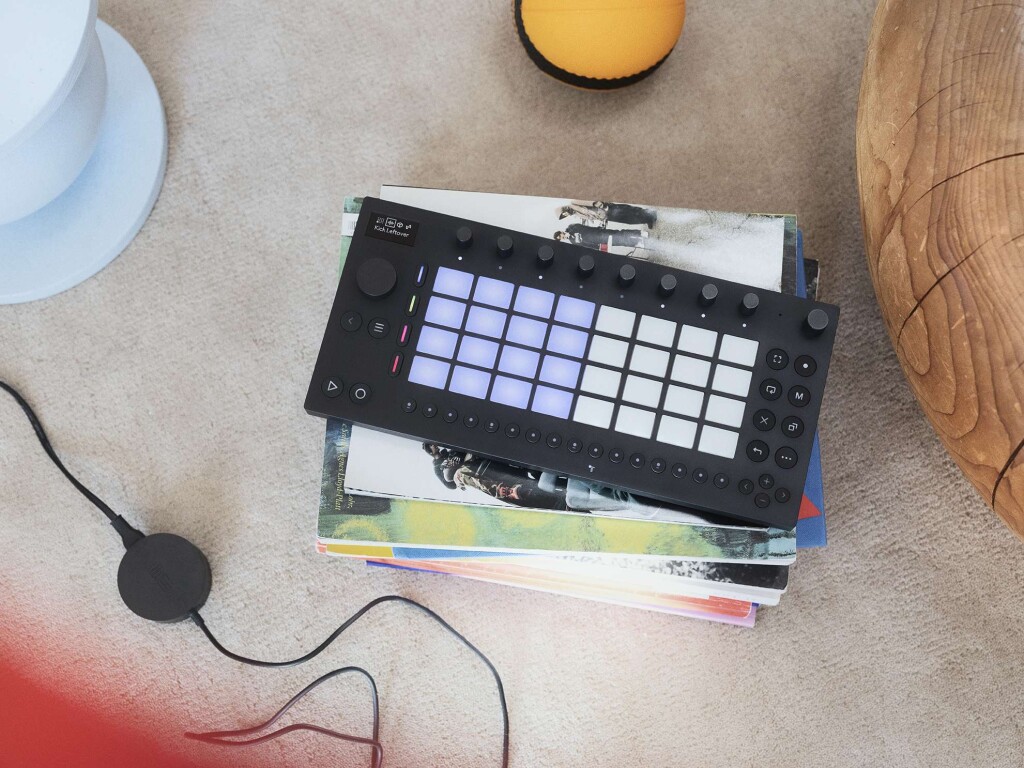
That means there are a few different use cases here:
- It’s a compact sampler instrument.
- It’s a portable sequencer.
- Mobile/mobile workflow: You can use it as a standalone instrument – or even exchange files bi-directionally with Note for iOS.
- Mobile/desktop workflow: You can also use it as a portable Ableton Live scratchpad (like Note, but with hands-on control and I/O).
- You could use it as a controller for the desktop Live – a “baby Push” that fits more easily into your bag and onto your desk.
And most obviously, it’s standalone Push hardware at a fraction of the price of Push 3 standalone. You don’t get the new expressive grid that’s on Push 3; these are the Push 2 grid buttons, though they do still have velocity and continuous pressure. They’re nice enough, and you can still bend between notes, even if not quite as gracefully as on the new Push. But at this price, that’s a major breakthrough.
The feel of the buttons and encoders, quality of the LEDs, and that grid means this feels way more premium than, say, a Novation Circuit or current-gen Korg Electribe. But it does have some of the inspirational simplicity of a Circuit. It even feels a bit like a more refined spiritual successor to Circuit, much as Push 1 took the mantle of the Launchpad and Akai APC.
Specs, features, connectivity
Even those use cases above don’t tell the whole story. Whereas Push 3 standalone commanded a premium price point, the ARM-powered Move squeezes in standalone features generally associated with devices costing twice as much. The main limitation is having four tracks – but that also massively reduces the amount of cognitive overhead playing around with the instrument. And the sampling alone is appealing.

- Standalone operation; Ableton claims “up to 4 hours of music making” per charge. It can also run on USB-C power.
- Four assignable tracks. Each track can be set to Drum mode, Melodic mode, or as a sampler. (You can also sample into Drum mode.) Those also can be routed as MIDI output, so they’re four tracks of sequencing, as well.
- Session Mode for standard Live clip triggering.
- Sampling from the stereo line input, built-in microphone (which was very usable), or resampling from tracks. This is the problem with links – saw some people who thought you can’t sample from stereo input, but you absolutely can; I’ve been doing it the last couple of weeks.
- Repeat, Capture features; parameter automation.
- Built-in instruments: Drum Sampler, Wavetable, Drift, Melodic Sampler.
- Built-in effects: Reverb, Delay, Saturator, Chorus-Ensemble, Phaser-Flanger, Redux, Channel EQ, Compressor.
- Built-in Ableton Link.
- Transfer sets to and from Ableton Note (bi-directional).
- Transfer sets to Push 3 standalone and Ableton Live (one-way, since Move has a subset of Live’s features).
The Wi-Fi connection is essential here. Once you key in the password for your Wi-Fi, you unlock a number of features. Move can update itself over-the-air, for one. But just as importantly, you get wireless support for file transfer and the ability to jam with other software and devices using Ableton Link. Link is terrific, as it means Move, Ableton Live, Push standalone, and a bunch of desktop and mobile hardware sync up. That means some quick jamming possibilities with friends with iPads, computers, other Move or Push hardware — whatever is on hand, minus the usual configuration. If you do need sync, MIDI works too; just connect an interface to the USB port.
File transfer is a new development I think I’ll cover separately – Live, Move, Note, and Push now all let you seamlessly move files through the cloud. With an iPhone running Note (or another Move), you can transfer files back and forth. Or you can start files on Move and then transfer them wirelessly to desktop. See Move Manager:
Move is also bundled with Ableton Live Intro 12.1, which includes the new Auto Shift for pitch correction and harmonization. Auto Shift is unfortunately not on Move, though – not yet, anyway – so that’s accessible only when you use Move as a controller. But the new 12.1 Drum Sampler and auto-tagging audio obviously go hand in hand with Move (and Note and Push 3, for that matter); you can grab a ton of one-shot samples on the go and intelligently tag them for later use. On Push 3 and Live desktop, you can also slice up those samples, though not on Move (you can slice on input, MPC style).
Hardware specs:
- 32 velocity-sensitive, backlit silicone pads
- Touch-sensitive, clickable jog wheel
- 16 backlit multifunctional buttons
- 9 high-resolution encoders
- 1.3″ white OLED display
- Stereo Line Out and Stereo Line In (3.5mm)
- Built-in microphone and speaker
- Built-in WiFi
- 64GB Internal storage
- USB-C Port to connect to computer
- USB-A Port to connect MIDI devices [USB host]
- Dimensions: W313.5 x D146.3 x H34mm
- Weight: 0.97kg / 2.1lbs
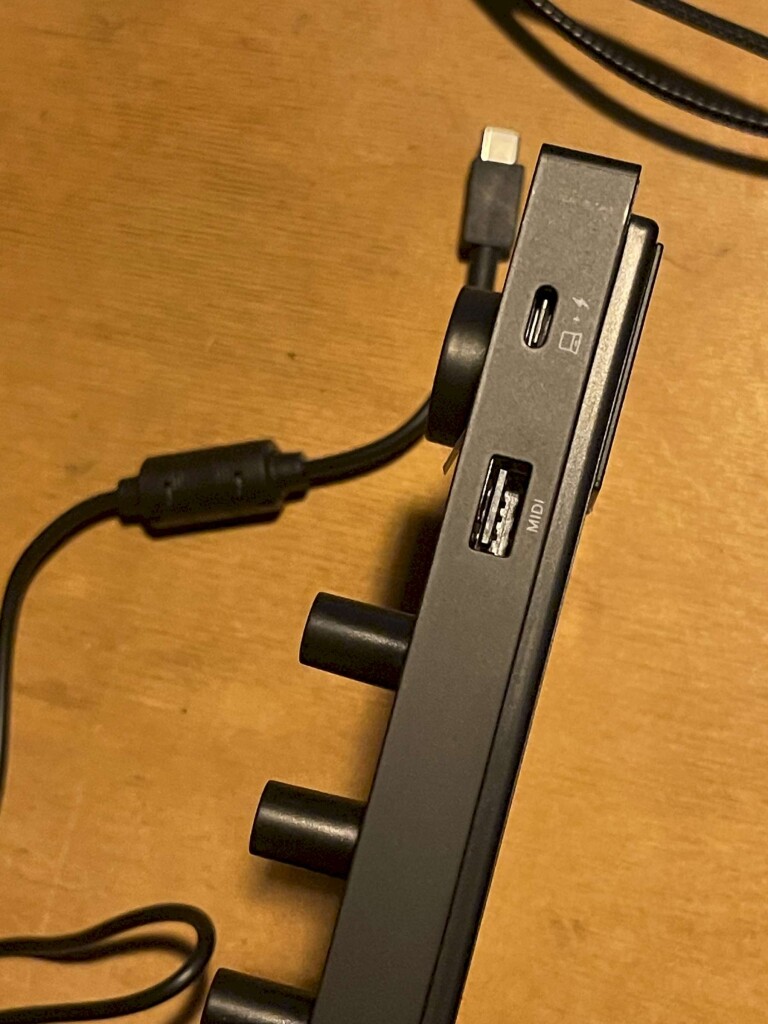
The result is portable, but still weight-y enough that it feels solid and it’s ultra-stable on a surface, in case you want to wail on it while finger-drumming.
The built-in speaker is not great, but it works in a pinch – if you need to test something quickly, for instance. The 1.3″ OLED you’ve seen before on … sort of every device below $500 from every music tech manufacturer on the planet. What Ableton has done with that display is make some cute, minimalistic icons that look very reminiscent of Elektron’s, with a certain Ableton-ish flair.
MIDI connectivity is likely to raise some eyebrows. it’s just a USB-A port. The good news is, that’s a USB host, so you can connect external controllers. MIDI support on those devices is limited, though: pitch, velocity, and even key pressure (with polyphonic aftertouch) all work, but there’s no MIDI clock input (only output), no MPE, and no MIDI CC. For some reason, there’s also no pitch bend support (weird), and only polyphonic aftertouch is supported – not the more commonly found channel aftertouch.
Still, this opens up some MIDI keyboard support, and hopefully they patch these other functions later.
What most people will use the MIDI-A port for is more likely MIDI in/out support – so you can send pitch and velocity sequencing to outboard devices, and MIDI clock out for sync with hardware (since Ableton Link is still rare on hardware devices).
This means you can also use Move with our own MeeBlip cubit duo. The three output ports will let you connect multiple clock outs with near-zero latency, and optionally do some light sequencing in and out.
It’s a compromise, for sure, but it also bears saying that this is an extremely compact, low-profile device – read those dimensions again.
Workflow, sequencing, building up ideas
You basically already know how to use this, having been trained on not just devices and software from Ableton Live but devices like Novation’s Launchpad. (It even, wisely, mirrors a lot of the simple, color-coded, one-button access to instruments from Novation. And I’m sure it’ll fit in nicely with a lot of Novation gear, like the Launchkey MK4 – which gives you a quick keyboard.)
Here’s the surprise: this is a far quicker, more intuitive workflow than Push. That’s for two reasons. One, a row of x0x-style step buttons lie underneath the grid, so that you can not only sequence on the pads, but also Roland TR-style with steps on the bottom. Two, there are the ingeniously designed action buttons on the right, which have dedicated, single functions – no shift functions. Right-to-left and top-to-bottom, those are:
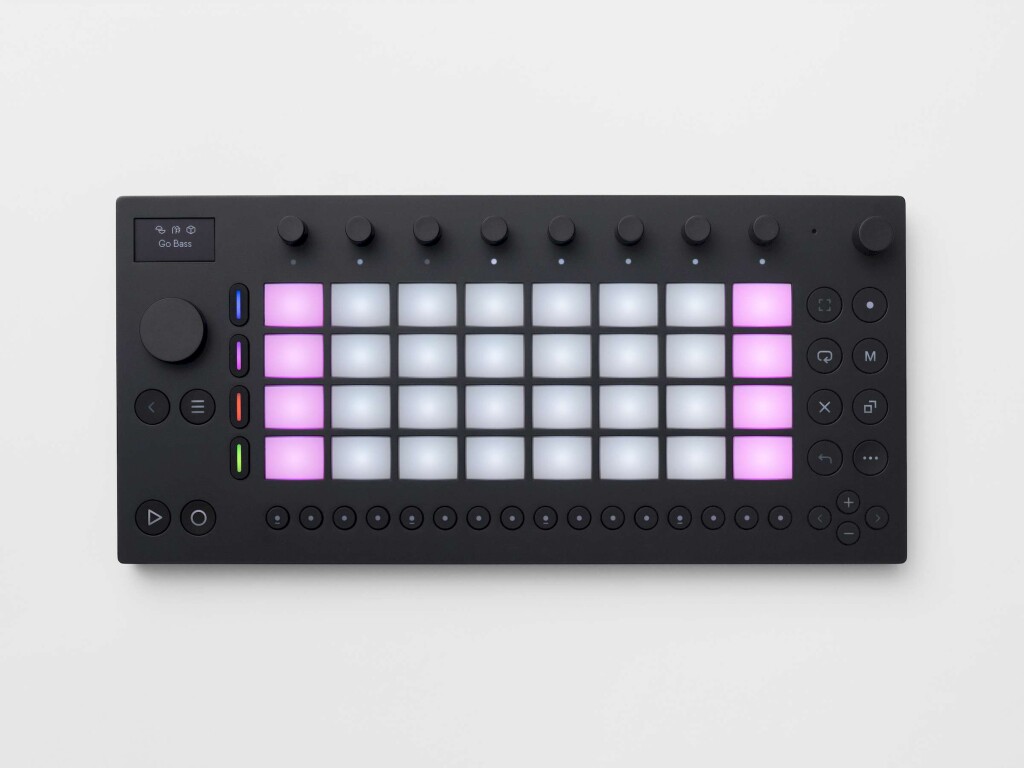
- Capture, which magically restores the last bit of what you were playing in case you accidentally improvise something clever and don’t want to lose it.
- Sampling, for one-button access to sampling inspiration (which is fantastically fun from the mic).
- Loop Mode for setting the loop length.
- Mute.
- Delete for clearing that clap solo that honestly never should have happened in the first place and needs to be erased from the universe.
- Copy (which turns out to be essential for the one-shot samples since there’s no slice after recording, but still…)
- Undo.
Below that, the directional buttons are octave (+/-) and bar (previous/next).
Look, all of this is possible on Push. Much more is possible on Push. Yet somehow Move feels like it does more, because it’s so much easier to learn these seven keys. Both Live and Push have the exact same capture feature. Have I ever used it? Honestly, not once, outside of reviewing the software. When did I use it on Move? Within the first three minutes of turning it on.
The same feeling is there with recording. As you may have guessed, I judge all hardware with sample capability against the mighty Casio SK-1. Having one-button record access here is ingenious. It’s all the stupid fun of sampling: record something, play it back, change start/end, transpose, then f*** around. That’s all it is.
I’m sure Ableton imagine that Move is for beginning users. And sure, it is – you may have never really gotten into Live, even, and you could pick this up and start using it. But I think who it’s for, secretly, is everyone. Even from some fairly advanced Ableton Live users, I’ve found a lot of people complain that Push isn’t really for them. I think the reason for that is that the cost of Push’s expanded functionality is added cognitive load, which even accounting for neurodivergence is important in live and improvisatory situations. Move has done an amazing job distilling the best bits of Live and Push into far more elegant interactions – much as Note did. You might have missed that on Note, though, just because of how unsatisfying and unmusical phone touch interactions are. Dedicated hardware is a revelation.
That brings us to the single shift button – the “…” on the bottom right. Hold this, and the x0x sequencer row changes to a series of function keys, with icons appearing out of the blank black space below. Here’s the one button I imagine many of you will wish was dedicated, but isn’t. Repeat is unfortunately tucked into this shift menu. Once it’s toggled on, you still get the ability to dial in repeat rate. But that means Push remains the champion for playability, with touch-strip access to repeat rate and its own repeat button. There’s also just no Accent button – it’s gone. There are some blank buttons left, though, so there’s hope we’ll get some updates. I just sorely wish they’d put Record somewhere else so that we got a dedicated Repeat.
You’ll get various functions here, though – left to right:
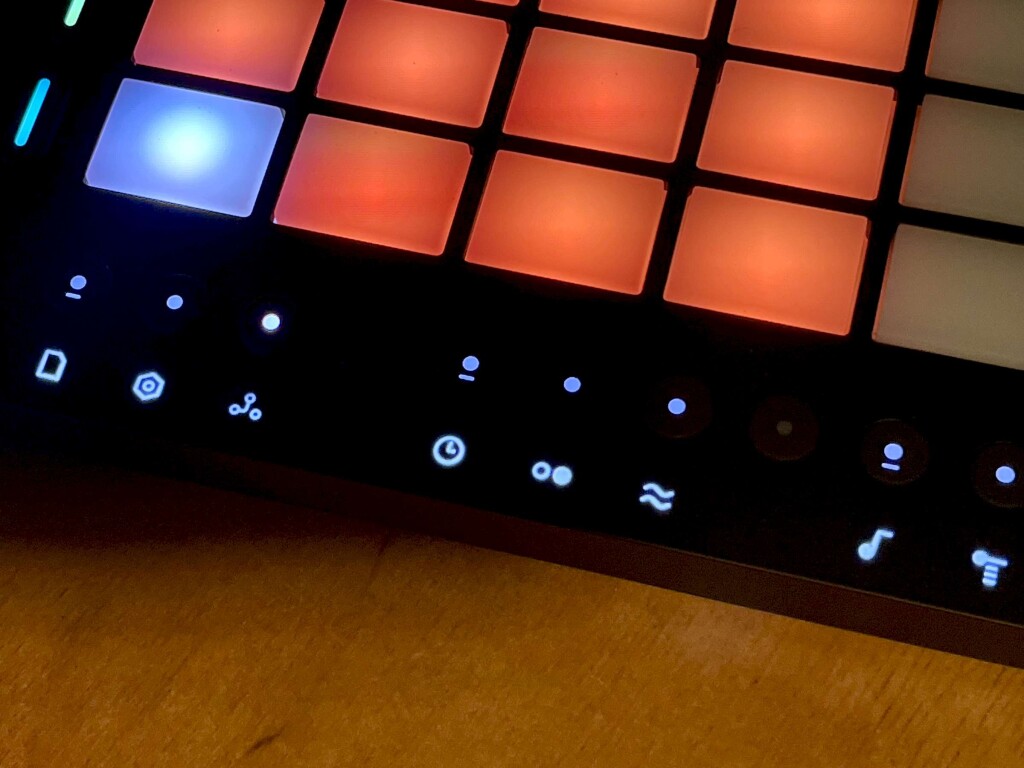
- Set Overview: load sets on the fly, just as in Note, just as not in Live! Perfect for playing live…)
- Setup: hardware setup options.
- Workflow Settings: quantize, step grid, count-in on/off, and autoload.
- Tempo (which will set itself automatically on the fly, just as in Note)
- Groove, which for now supports just swing 16ths (hopefully expanded to other Groove Templates soon). Corrected: The first version of this story incorrectly said there was support for switching templates.)
- Keys & Scales (unfortunately, no tuning support, which I hope they address)
- Full Velocity toggles fixed velocity and velocity sensitivity
- Note Repeat (also controls Arpeggiator)
- Double Loop
- Quantize
Some of the icons are crystal-clear and nicely aligned with Ableton Live – like the Groove, Tempo, and Metronome icons. Some of them make sense once you work out what they are – the curves on Note Repeat are like repeating notes, Quantize and Full Velocity are abstracted from Live Clip View, and so on. Some are just odd, like the Babylonian-looking Workflow Settings and the decision to represent Keys and Scales as an eighth note flag, rather than, like, an accidental/key signature, breaking from about 1000 years of tradition. But the on-screen icons are all very clear and these you’ll learn in the course of an evening or two.
Having praised the simplicity here, I am sure some of you will still miss having dedicated keys for Double Loop or Quantize, too, or dedicated Tempo access, and then Move might not be for you. Then again, no one has made a device that’s this portable and this capable at the same time – this is like Push standalone-level functionality in something close to the size of a Teenage Engineering OP-1, for crying out loud.
Arrangement is likewise easy – build up your songs via clips, in the classic Live style.
Here’s the bottom line: playing in ideas on Move is about as fast as anything, ever. Build up your four-part ensemble, press a part, step sequence on pads or step sequence on the 16-step sequencer. Or play live on the pads. Or quickly play in some samples. Tweak and shape on the encoders. Use the step buttons to make per-step tweaks (parameter locks). It’s brilliant. You’ve done all of it before. It’s just in a stupidly convenient, incredibly flexible form.
Of course, anyone who loves trackers, this is not a tracker – Dirtywave M8 lovers, feel free to dump on Move. A drum and bass contest between Move and M8 is likely to end really badly for the Ableton user. And you should look at Tracker Mini, too. But before I get into religious territory, moving on:
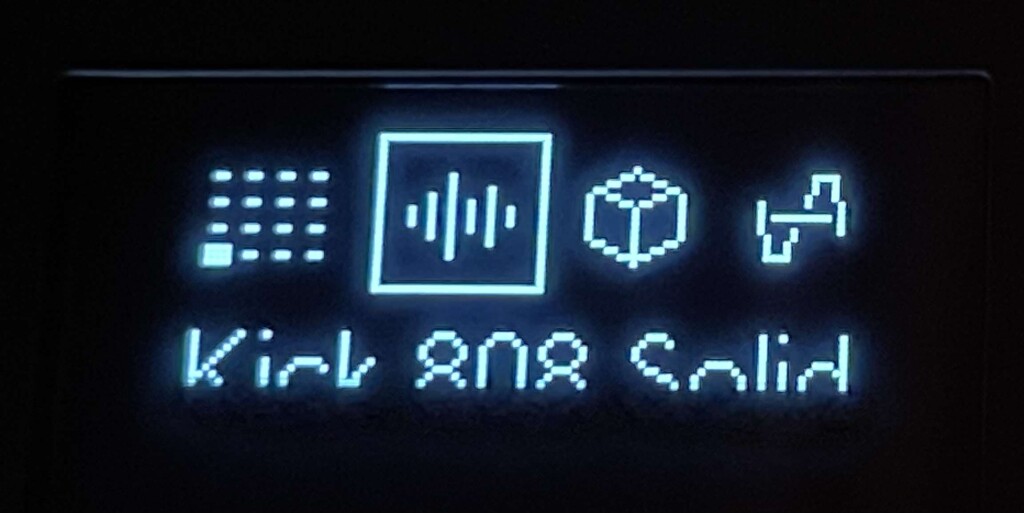
Sounds, instruments, and effects
It’s tough to overstate just how good the sound programming and voicing are on Move. (Those sounds are evidently coming soon to Note, too – for free – so wow.) Even the demo sets sound better than past Abeton efforts. Ableton seems to have done great work with artist collaborations on this.
What can I say? The best stuff is here: Drift and Wavetable are two of the best instruments. Move out of the box is honestly a bit too clean and antiseptic for me, but between Redux and Saturator (and some fantastic presets for them), that will last all of a couple of seconds before you add as much destruction as you want. The effects otherwise cover all the basics.
There is some room for growth. I’d love to see Operator; maybe its absence means there’s an Operator refresh coming at some point. And I wish Ableton had been a little braver and given us something like Grain Delay or anything other than just a vanilla Delay. Just please, don’t cripple Move just to differentiate from Push. I love Push 3, but I just don’t like traveling with it.
Sampling
Sampling is probably what puts Move in must-buy territory for a lot of people. This is just exceptionally good, and it means that while Ableton are largely promoting the built-in sounds and sequencing, you can make Move into an absolute beast alongside other gear and the mic. Jamming with some vintage synth you managed to find at a friend? Mucking around with modular? Grab it on Move.
The combined Drum Sampler and Melodic Sampler, just as on Live 12.1, then give you stupidly easy sample manipulation. It’s a little simplistic, but quick and fun, especially once you’re doing SK-1 style repitching and fast-and-furious drum slot sampling.
But, but, but – the inability to slice here to me is a major oversight. I don’t need some really fancy slicing and time-stretching facility, and yes, of course, limitations can spawn creativity, yadda yadda. The problem is this – while one-shots and melodic repitching is easy, if you want to take a sample and make it into a drum kit, that’s a chore. And then everything slows to a crawl: one at a time, copy samples to slots and then sloooowly find the start and end points.
The best way for now to work around this is multi-pad recording, as on the first-gen MPC. You’d enter Sampling Mode and slice up samples as you record by pressing the different pads to set start points on the fly. It’s even possible to use this workflow after the fact, via resampling. But it would benefit from the addition of slicing by transient detection or beat division, at least. They demonstrate that in the video here:
Ableton already added one-button slice-to-MIDI to Ableton Live in Live 7, ca. 2008. (I checked; I reviewed that version.) It doesn’t have to work perfectly, either – a crude 32-slice function would keep you in the flow, and if it worked a little differently each time, that could also be creative. (And maybe we’ll get lucky and Note and Move can come up with a better way of doing this for Live and Push.)
Everything else here works as you’d want, from the record button to internal mic to easily spotting the waveforms on Drum Sampler to resampling. (Resampling alone is wonderful.) I’m almost sure this is coming in something like “Move 1.5” and – you heard it here first, when it hits, Move will have a ton of fresh converts.
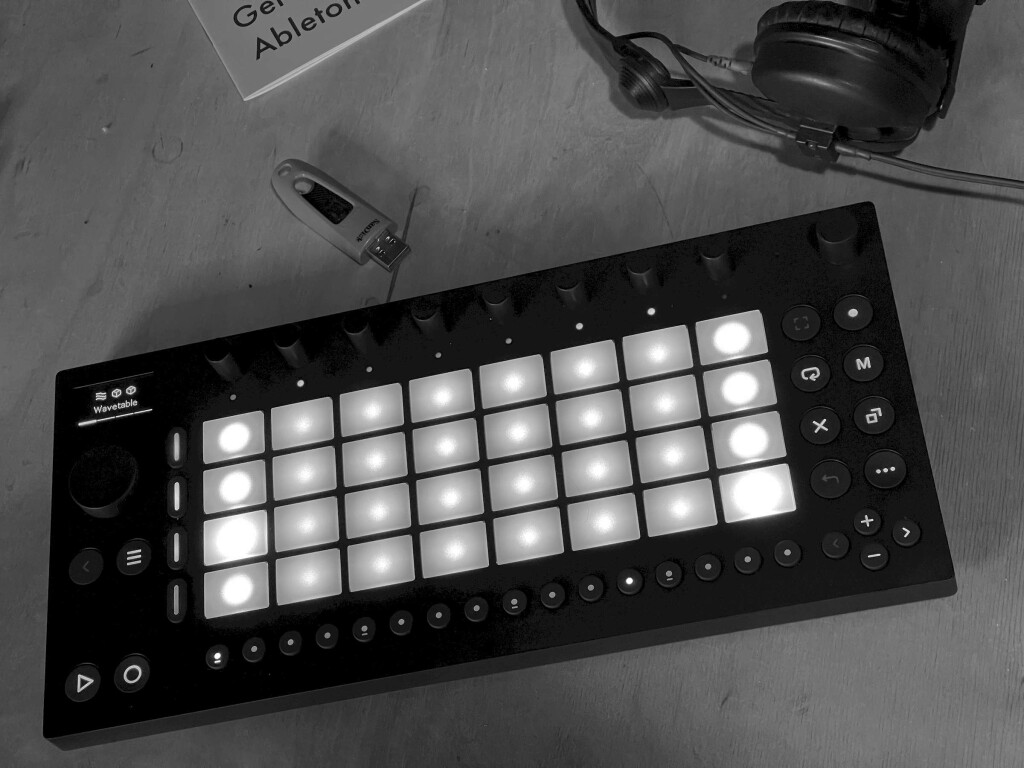
Conclusions
For under 500 bucks, Move fits a whole lot of setups. USB host and Link support, plus file exchange with Note, mean it’s a great mobile device. It’s also a convenient compact sequencer and sampler companion to your other instruments. I do wish it had CV in and out like Arturia’s compact devices – it’s three minijacks away from replacing the BeatStep Pro and such alongside Eurorack. But as long as you can stomach going via a MIDI adapter, this also makes a nice companion to analog and modular gear. You can use any or all of the tracks for MIDI sequencing, there’s clock (over MIDI as well as obviously Ableton Link), and it’s a convenient sampler, too. The Push 2 pads are also not going to be everyone’s favorite – so just for finger drumming, you might look elsewhere – but the pads + workflow balance out in the complete package.
Push 3 also still has some major advantages if you’ve got the cash. For an expressive grid, for the full set of instruments and effects (including Max for Live), greater I/O (including audio expansion), CV/gate capability, a big display, and more, Push is still the flagship. But it’s also more likely the flagship you’ll leave at your desk or studio.
Look, Move is great. If you’re a Live user with a controller combo you like and don’t care much about the mobile functionality, you’ll probably pass on this. But for anyone who wants to get away from their computer now and then, if you like the grid/step sequencer workflow, this looks like an instabuy. Apart from mobile trackers, there’s just nothing else that has quite this much functionality in a compact form – not from anyone, not Korg, Yamaha, Roland, Teenage Engineering, Novation, anyone. There are other mobile sequencers and other mobile samplers, but nothing that marries those two workflows quite like this – if Ableton will just add slicing.
And I do think mobile trackers are the main competition, especially Polyend Tracker Mini and the much-anticipated M8: Model 02. (Plus, there is still Novation with Circuit Tracks and Circuit Rhythm, each of which has a pretty low price. Though – trackers for those broken/jungle/drum and bass grooves… you know…)
My prediction: Ableton is going to be surprised by how hot this item is.
Even more interesting, though, will be to see where Ableton takes Move and its ARM-powered architecture. With more expandability and customization, Move could go into entirely new territories. And this is not a minor announcement: it’s an entirely new Ableton platform with dedicated ARM architecture, joining the Intel/Apple Silicon desktop, Apple Silicon iOS, and Intel NUC Push 3 standalone platforms. Of all of those, I think it’s the platform that excites me the most.
More videos
Nick has a great interview/walkthrough with the Abletons:
We are going to see a lot more videos like this: